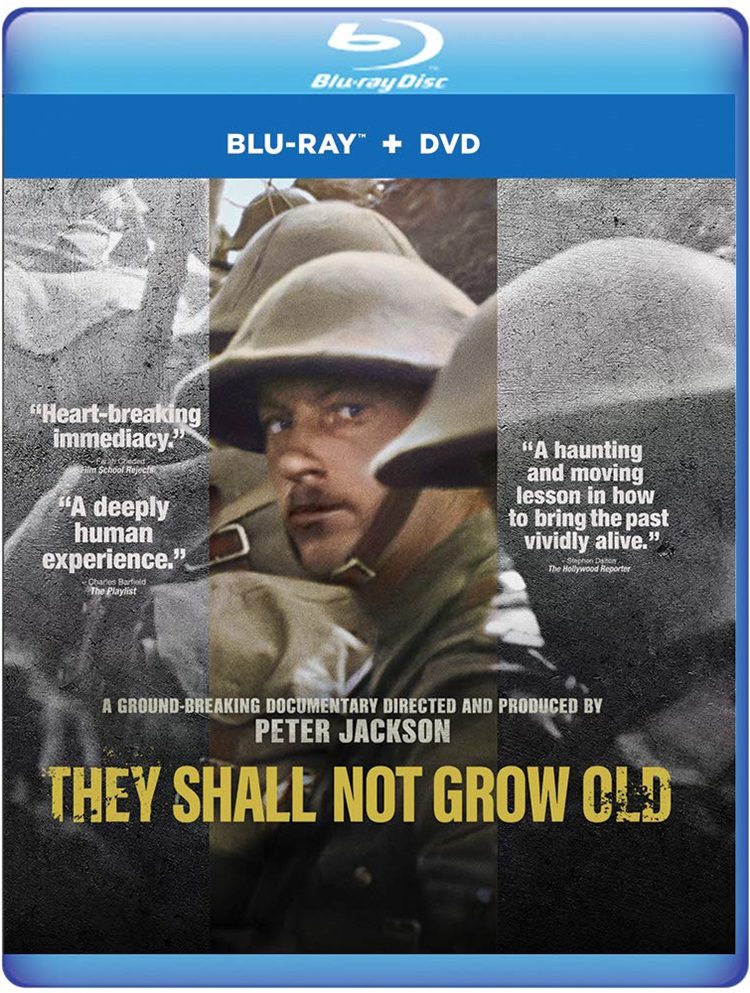
Taking old black and white footage and adding color to it is nothing particularly new. Some documentaries have already done so to footage from World War II and other historical events, making it appear as it was mostly seen through the eyes of those that experienced it. Peter Jackson’s latest effort, They Shall Not Grow Old, does the same thing for World War I but to a much different, more gut-wrenching effect than any other documentary on the subject.
The war footage used is 100 years old, meaning that the frame rate makes it look like each individual person is running everywhere they go, there is no sound, and it’s also got a bunch of dirt and scratches from the aging process. In the film’s first 15 minutes or so, we see footage as it is untouched. It’s still riveting to see and an intriguing look at how events were filmed at that time. The narration is provided by archive interviews with unnamed veterans of World War I, giving viewers their experience in horrifying, and yet sometimes very humorous, detail. If there had been just one person giving narration and explaining everything from a historical perspective, the authenticity would have not been present.
Jackson takes his time before he reveals the big project he and his crew have worked on for four years with retouching the footage, adding color and sound to it, and increasing the frame rate from 15fps to 24fps. The result is unlike anything you’ve ever seen, and the documentary’s approach is far different than the normal, lecture-style that people watch during their history classes or on the History Channel (when it actually does show something like this and not an alien-conspiracy special).
They Shall Not Grow Old was a project commissioned by the British Imperial War Museum and the BBC to commemorate the 100th anniversary of Armistice Day. Jackson, an avid WWI memorabilia collector, went to great lengths to make sure no details were left out in terms of how the uniforms would look if the footage was in color and captured the same way with today’s technology. Jackson strikes the viewer without warning when he’s going to transition the film from the original stock footage to what he and his team at WingNut Films were able to accomplish. The minute the film zooms from the distant, telescopic view of the war in black and white to a full-screen, richly and realistically detailed look, it’s as if we just got placed alongside the soldiers and are experiencing the moments with them.
As explained in the 30-minute, behind-the-scenes documentary that aired afterward, there is no footage capturing the actual battle scenes that took place against the British and Germans. Obviously, it was too much of a risk, and, in addition, the cameras used back then weren’t easy to carry around. As a substitute, Jackson inserts restored still shots of soldiers killed in action after showing them in the footage. Another method was done by inserting covers of a magazine on the war that came out during that time, while the veterans described their experiences. To capture what the sounds were back then, Jackson hired sound designers to recreate the sounds of artillery being fired, feet stomping in the mud, and the impact of a bullet hitting a soldier. This method is more effective and more horrifying than any recreated battles in movies about the war, such as All Quiet on the Western Front, or even other war films like Saving Private Ryan and Dunkirk. We’re not seeing actors facing terrible situations; we’re witnessing the actual events as experienced by those who served. The 3D effect adds another whole layer to the detail that a 2D presentation would seriously lack. While there aren’t any objects flying out of the screen, there is more of a feeling that these people just came to life again right in front of you.
Some of the scenes in the documentary feature soldiers speaking. Again, back during that time, there was no way to capture what was being said. For this, Jackson employed professional lip readers to understand what was being said and dubbed their voices into the scenes when it was needed. While we will never know how the people actually sounded, this method comes as close as it possibly could. And the dialogue that is used matches the soldiers’ lip movement perfectly.
The archived interviews used for the narration have veterans explaining their motives to join the military and fight in the war, as well as their detailed experiences on the smells that surrounded them and the food they were subjected to eat. The footage first shows the young men being cheery and excited about enlisting, but then transitions to time passing and them being scared and questioning why they signed up for such a terrible experience. The audio smoothly matches the passage of time and how they felt before and after the war. Jackson could have easily made They Shall Not Grow Old an anti-war statement, but instead keeps it to just being about those who were there and what their experiences were like.
They Shall Not Grow Old captures history in a way no other documentary has before and makes the viewer feel as if they are right next to the soldiers, witnessing the same horrors they are. Not only is it a must for history buffs, but it is also one for those with a passion for cinema. It’s a masterful achievement that rattles viewers, leaving them stunned in their seats as an old wartime song, “Mademoiselle from Armentières,” plays over the credits.